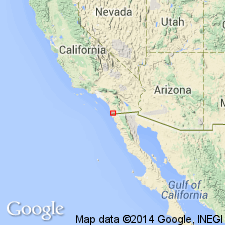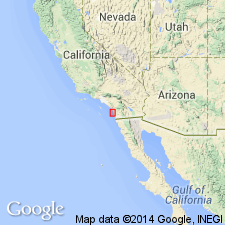
- Usage in publication:
-
- Bay Point formation
- Modifications:
-
- Original reference
- Biostratigraphic dating
- Dominant lithology:
-
- Sand
- Gravel
- AAPG geologic province:
-
- Peninsular Ranges province
Summary:
Pg. 63 (fig. 4), 71-72. Composed of sand and gravel terrace deposits. At type, light gray cross-bedded sands contain abundant specimens of DENDRASTER and DONAX LAEVIGATA. Has larger fauna at Pacific Beach. Thickness generally 5 to 10 feet; maximum 20+ feet. Columnar section shows unit is younger than Sweitzer formation and older than Recent [Holocene] alluvium. Age is Pleistocene based on molluscan fauna.
Named from exposures along west shore of Bay Point [now Crown Point] in Mission Bay, [La Jolla quadrangle], San Diego Co., southern CA [= type locality].
Source: US geologic names lexicon (USGS Bull. 1200, p. 245); GNU records (USGS DDS-6; Menlo GNULEX).

- Usage in publication:
-
- Bay Point Formation*
- Modifications:
-
- Adopted
- Age modified
- AAPG geologic province:
-
- Peninsular Ranges province
Summary:
Bay Point Formation of Hertlein and Grant (1939) is adopted. Unit has been uplifted near Rose Canyon fault in La Jolla. Overlies Linda Vista Formation. Age is late Pleistocene (Sangamon) or about 100,000 yr B.P. on basis of its extensive molluscan fauna (citing Kern, Stump, and Dowlen, 1971).
Source: GNU records (USGS DDS-6; Menlo GNULEX).
For more information, please contact Nancy Stamm, Geologic Names Committee Secretary.
Asterisk (*) indicates published by U.S. Geological Survey authors.
"No current usage" (†) implies that a name has been abandoned or has fallen into disuse. Former usage and, if known, replacement name given in parentheses ( ).
Slash (/) indicates name conflicts with nomenclatural guidelines (CSN, 1933; ACSN, 1961, 1970; NACSN, 1983, 2005, 2021). May be explained within brackets ([ ]).

